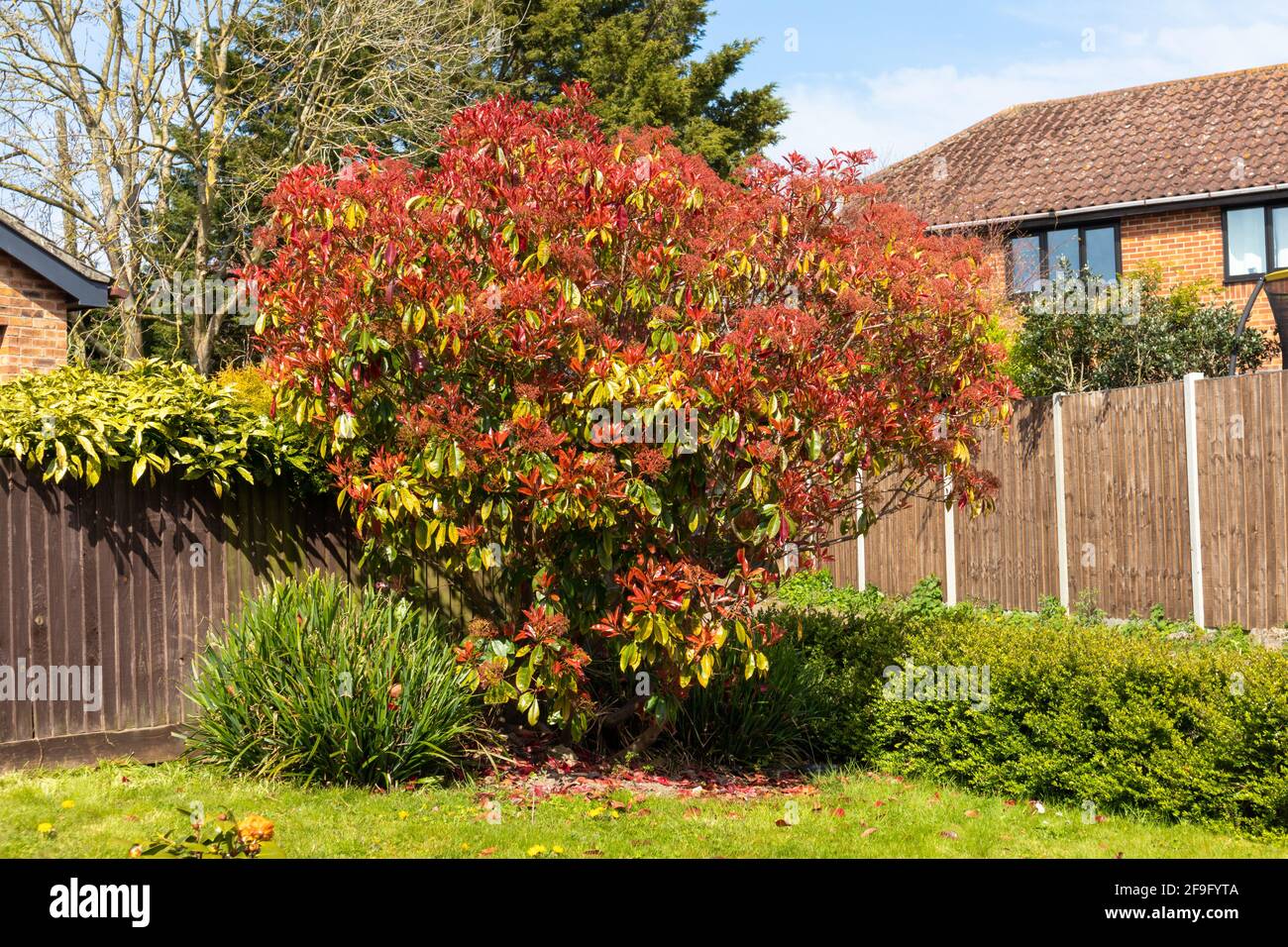Red Robin photinia is a popular evergreen shrub prized for its bright ruby-red new foliage that emerges in spring. It grows quickly when young but may eventually reach over 15 feet tall and wide when fully mature. Here’s what to expect as your Red Robin photinia grows into a full-size specimen over time.
Red Robin Photinia Facts
-
Botanical Name: Photinia x fraseri ‘Red Robin’
-
Also Called Christmas berry
-
Deciduous or Evergreen: Evergreen
-
Mature Size: 12-15 feet tall x 12-15 feet wide
-
Growth Rate: Moderate, about 1 foot per year
-
Sun Exposure: Full sun to partial shade
Appearance of a Mature Red Robin Photinia
Form and Size
-
Habit: Rounded, spreading form with horizontal branching
-
Trunk: Gray bark that develops shallow fissures with age
-
Height: Typically grows 12-15 feet tall at maturity in 10-15 years. Can reach 20 feet.
-
Spread: Grows as wide as tall, so mature spread is around 12-15 feet.
-
Density: Branches and leaves create a thick, dense crown.
Leaves
-
Color: Emerging leaves are ruby-red, turning glossy green.
-
Size: 2-4 inches long; leathery texture
-
Shape: Oblong with toothed edges
Flowers and Fruit
-
Flowers: Small white flowers in spring
-
Fruit: Clusters of tiny red berries in late summer/fall
Growing Conditions for Red Robin Photinia
-
Hardiness Zones: 7-9
-
Soil: Moist, well-draining soil, acidic to neutral pH
-
Light: Full sun for best color, but also tolerates partial shade
-
Water: Moderate water needs, drought tolerant when established
Tips for Pruning a Mature Red Robin Photinia
-
Prune annually in late winter/early spring to maintain shape and vigor.
-
Remove up to 6 inches from branch tips to encourage new red growth.
-
Thin out overcrowded interior branches to improve air circulation.
-
Cut back older stems close to the base to renew leggy plants.
-
Avoid shearing, which damages the red foliage. Make clean cuts.
Issues to Watch for in Mature Red Robin Photinia Trees
-
Sparse interior growth and leaf loss due to poor air circulation. Thin branches to improve.
-
Powdery mildew fungal disease causes leaf spotting. Improve air flow.
-
Cold damage to new red shoots if grown in exposed sites. Choose a sheltered location.
-
Outgrowing its space in the landscape. Allow enough room or prune regularly.
With proper placement and pruning, a mature Red Robin photinia can be a beautiful evergreen specimen tree that provides year-round interest in the landscape.
All you need to know Before you get started
Photinias are shrubs or small trees from China. There are several species, some are evergreen and others
Deciduous refers to plants (mainly trees and shrubs) that lose their leaves seasonally, usually during autumn. This is a natural process that happens when the days get shorter and the temperature drops. It helps plants save energy during the winter.
Choosing the right photinia for you
You can pick from a number of species that have beautiful seasonal foliage displays, clusters of small white flowers, and red berries. Whether your garden is formal or casual, big or small, they look good there. You can grow them as specimen trees, shrubs, hedges, or wall shrubs. Some species need neutral or acid conditions, so will not grow well in chalky/alkaline soil. They can also be grown in large containers if your soil is unsuitable. See our guide to understanding soil pH. Some photinias can get very big, up to 5m (15ft) after 10 years or more, so make sure you know what size it will be before you buy it. Give larger species plenty of space or be prepared to prune annually. The most common type, Photinia fraseri Red Robin, is a beautiful ornamental shrub, especially in the spring and summer when its red young leaves stand out. It can be grown as a shrub or a hedge, and its evergreen leaves make a dense screen all year.
Evergreen shrubs make useful, sheltered nesting sites for birds in early spring.
Photinia Standard – Red Robin – YouGarden
FAQ
How big does Red Robin get?
Does Red Robin have invasive roots?
Where is the best place to plant Photinia Red Robin?
Are red tip photinia fast growing?
- The Ultimate Guide to Growing Strawberries in Raised Beds - August 8, 2025
- No-Dig Garden Beds: The Easiest Way to Grow a Beautiful Garden - August 6, 2025
- How to Protect and Preserve Wood for Raised Garden Beds - August 6, 2025

